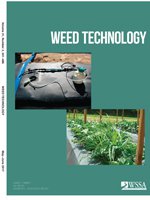Field experiments were conducted at the North Central Agricultural Research Station in Fremont, OH in 2009 and 2010 to evaluate the tolerance of tomato to fomesafen and the efficacy of this herbicide on weed control. The crop was machine-transplanted in June 5, 2009 and June 3, 2010. Herbicide treatments were applied using a CO2 pressurized (276 kPa) backpack sprayer with 8002VS nozzle tips delivering 234 L ha-1. Pre-transplant (PRETP) treatments were applied on June 4, 2009, and May 27, 2010. Treatments included fomesafen at 280, 350, 420, 560, and 840 g ai ha-1. Minimal crop injury was observed 7 and 14 d after treatment (DAT) in plots treated with fomesafen at 840 g ha-1 both years. None of the treatments caused crop injury either year at 42 DAT. Fomesafen at the highest rate provided acceptable annual grass, common purslane, and redroot pigweed control 42 DAT. Tomato yield was not reduced by the application of fomesafen. Registration of fomesafen herbicide would provide tomato growers an opportunity to control weeds caused by late emergence or poor initial control following a burndown herbicide application in tomato.
Nomenclature: Fomesafen, tomato, Solanum lycopersicum L.





